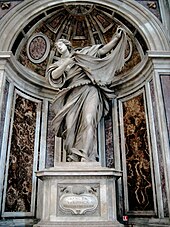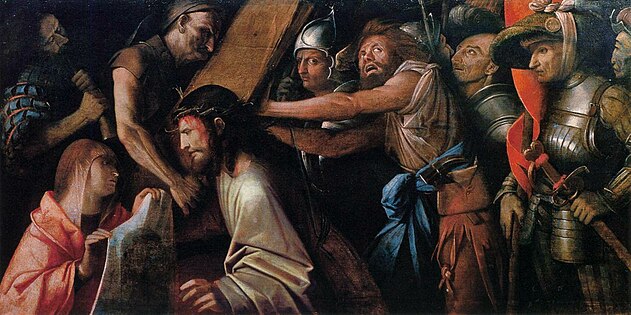Saint Veronica
Saint Veronica | |
|---|---|
Pre-Congregation | |
| Feast | July 12[1] |
| Attributes | Cloth that bears the image of Christ's face |
| Patronage | images; laundry workers, pictures, photos, photographers,[2] Santa Veronica, San Pablo City, Laguna |
Saint Veronica, also known as Berenike,

According to Church tradition, Veronica was moved with sympathy seeing Jesus carrying the cross to Calvary and gave him her veil so that he could wipe his forehead. Jesus accepted the offer, and when he returned the veil the image of his face was miraculously captured on it. The resulting relic became known as the Veil of Veronica.[6][7][8]
The story of Veronica is celebrated in the sixth
Background


There is no reference to the story of Veronica and her veil in the

At some point a relic became associated with the story. Pedro Tafur, a Spanish knight visiting Rome in 1436, describes the following in the Church of St. Peter in his 1454 travel account:[13]
On the right hand is a pillar as high as a small tower, and in it is the holy Veronica. When it is to be exhibited an opening is made in the roof of the church and a wooden chest or cradle is let down, in which are two clerics, and when they have descended, the chest or cradle is drawn up, and they, with the greatest reverence, take out the Veronica and show it to the people, who make concourse there upon the appointed day. It happens often that the worshipers are in danger of their lives, so many are they and so great is the press.
However, he does not say specifically that he witnessed for himself this exhibition of the relic.
Some academic sources suggest a different origin for the legend of St. Veronica: that the cloth bearing an image of Jesus's face was known in Latin as the vera icon ("true image"), and that this name for the relic was misinterpreted as the name of a saint. The Catholic Encyclopedia of 1913 writes:[14]
The belief in the existence of authentic images of Christ is connected with the old legend of King
Mors Pilati ("the Death of Pilate"). To distinguish at Rome the oldest and best known of these images it was called the vera icon (true image), which in the common tongue soon became "Veronica". It is thus designated in severalmedieval texts mentioned by the Bollandists (e.g. an old Missal of Augsburg has a Mass "De S. Veronica seu Vultus Domini" – "Saint Veronica, or the Face of the Lord"), and Matthew of Westminsterspeaks of the imprint of the image of the Savior which is called Veronica: "Effigies Domenici vultus quae Veronica nuncupatur" – "effigy of the face of the Lord which is called a Veronica". By degrees, popular imagination mistook this word for the name of a person and attached thereto several legends which vary according to the country. [translations in italics added]
The reference to Abgar is related to a similar legend in the Eastern Church, the Image of Edessa or Mandylion.
The Encyclopædia Britannica says this about the legend:[15]
Eusebius in his
Acta Pilati", the most ancient form of which goes back to the fourth century. The fanciful derivation of the name Veronica from the words Vera Icon (eikon) "true image" dates back to the "Otia Imperialia" (iii 25) of Gervase of Tilbury (fl.1211), who says: "Est ergo Veronica pictura Domini vera" (translated: "The Veronica is, therefore, a true picture of the Lord.")

Veronica was mentioned in the reported
The Devotion to the Holy Face of Jesus was eventually approved by Pope Leo XIII in 1885. Veronica is commemorated on 12 July.
Official patronage
Saint Veronica is the patron of the French mulquiniers whose representations they celebrated semi-annually (summer and winter) as in many pious Christian countries. She is also the patron saint of photographers, and laundry workers.
Gallery
-
Saint Veronica with the Veil, Mattia Preti
-
Saint Veronica by Bernardo Strozzi
-
Christ with the Cross on his back, encountering Veronica, Antonio Arias Fernández
-
Saint Veronica by Ángel María Cortellini Hernández
-
Veronica showing the Holy Face to the Virgin and Saint John, 1864, by Juan Antonio Vera Calvo
-
Road to Calvary with Veronica's Veil, Giovanni Cariani
-
Saint Veronica, 1902 by Rupert Bunny
-
Kempten Crucifixion, 1475 by unknown artist
-
Veronica and the Carrying of Christ, Gaspar de Crayer
See also
- Acheiropoieta
- Women at the crucifixion
- Jesus healing the bleeding woman
- List of names for the biblical nameless
- Relics associated with Jesus
- Scapular of the Holy Face
- Veronica's Veil
- Matthew 9
- Mark 5
References
- ^ Catholic Online
- ^ "Saint Veronica". Archived from the original on May 12, 2008. Retrieved April 19, 2008.
- ^ "St. Veronica - Saints & Angels".
- ^ a b "Stations of the Cross". Trinity UMC. 24 March 2013. Archived from the original on 17 April 2015. Retrieved 17 April 2015.
This tradition began most prominently with St. Francis of Assisi (1182–1226) and spread to other churches in the medieval period. It is also observed by a growing number of Anglicans, Methodists, and Lutherans. It is most commonly done during Lent, especially on Good Friday.
- ^ Harper, Douglas (November 2001). "Veronica". Online Etymology Dictionary. Retrieved 2007-08-24.
- ^ "St. Veronica", Notes and Queries, 6, London: 252, July–December 1852
- ISSN 0066-5983.
- ISBN 0-86012-256-5.
- ^ Vatican Website Sixth Station
- ISBN 978-0-06-185621-1.
- ^ Luke 8:43–48
- ISBN 978-0-385-26105-0.
- ^ Letts, Malcolm (1926). Pero Tafur: Travels and Adventures 1435-1439. George Routledge & Sons, Ltd.
- ^ Dégert, Antoine (1912). . In Herbermann, Charles (ed.). Catholic Encyclopedia. Vol. 15. New York: Robert Appleton Company.
- ^ Delehaye, Hippolyte (1911). . Encyclopædia Britannica. Vol. 27 (11th ed.). pp. 1037–1038.
- ISBN 1-931709-77-7.
- ISBN 0-89555-389-9.









